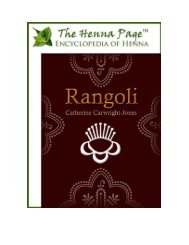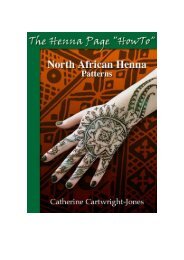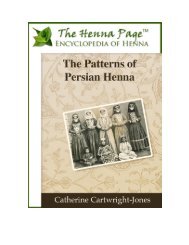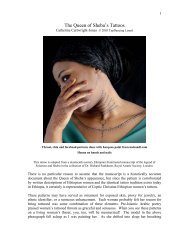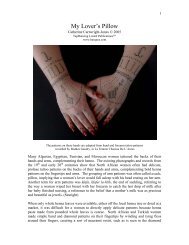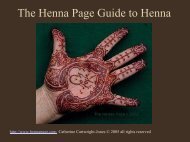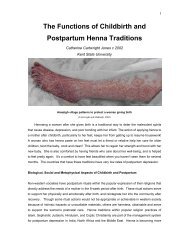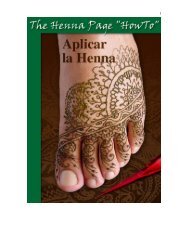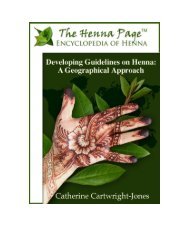Menstruation and Henna: Pollution and Purification - The Henna Page
Menstruation and Henna: Pollution and Purification - The Henna Page
Menstruation and Henna: Pollution and Purification - The Henna Page
Create successful ePaper yourself
Turn your PDF publications into a flip-book with our unique Google optimized e-Paper software.
has henna (Hammoudi, 1993: 121). Arab women used a combination of diamond patterns with<br />
written charms to protect the wearer (Addison 2001) as well as patterns intended to enhance<br />
beauty <strong>and</strong> eroticism. Sudanese women wear floral henna patterns to emphasize their femininity<br />
<strong>and</strong> to attract benevolent spirits (Boddy, 1989). Women used henna because their health <strong>and</strong><br />
fertility, <strong>and</strong> husb<strong>and</strong>’s love were never guaranteed, <strong>and</strong> they often wished to actively better their<br />
situation rather than passively accept “the will of God”.<br />
<strong>The</strong> Evil Eye was often considered the cause of lost fertility, lost love, lost health, <strong>and</strong> women<br />
often believed a rival wife or spirit had cast the evil eye. Persian women would henna intricate<br />
patterns that would entangle the Evil Eye so it would not touch their skin <strong>and</strong> penetrate their soul.<br />
Many believed that malevolent jinn, supernatural spirits were attracted to their menstrual blood,<br />
<strong>and</strong> that their evil intent could be thwarted by henna <strong>and</strong> protective patterns; jinn would “bounce<br />
off <strong>and</strong> shatter” if they touched star shaped henna patterns. Women soiled with reproductive<br />
blood were believed to be highly vulnerable to attack <strong>and</strong> possession by the Evil Eye <strong>and</strong> jinn,<br />
<strong>and</strong> henna was specifically believed to deter malevolent spirits <strong>and</strong> encourage benevolent spirits<br />
in Persia, Sudan, Morocco, <strong>and</strong> Mauritania (Boddy, 1989:250 – 1; Westermarck, 1926, I: VIII,<br />
Tauzin, 1998).<br />
<strong>Henna</strong> <strong>and</strong> Tannin<br />
Plant tannins, such as found in henna, react with collagen <strong>and</strong> keratin <strong>and</strong> preserve protein<br />
structures in skin <strong>and</strong> leather, keeping them supple, resistant to desiccation <strong>and</strong> degradation<br />
(Stankiewicz et al 1997, p. 1884-5). <strong>Henna</strong> stains protect skin by packing the “b<strong>and</strong>” regions of<br />
the fibrils with tannin, which prevents them from separating, thus preserving the macro-molecular<br />
structure <strong>and</strong> slowing the spread of decay or disease (Haslam E., 1989). Plant tannins preserve<br />
“<strong>Menstruation</strong> <strong>and</strong> <strong>Henna</strong>, <strong>Pollution</strong> <strong>and</strong> <strong>Purification</strong>”, was written by Catherine Cartwright-Jones as partial completion<br />
of the requirements for a Master’s degree in Liberal Studies focusing on henna, under the supervision of Dr. A Smith<br />
<strong>and</strong> Dr. N Ammar, Kent State University, Kent Ohio, USA<br />
8




